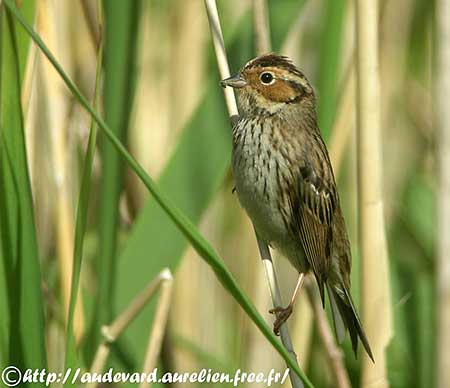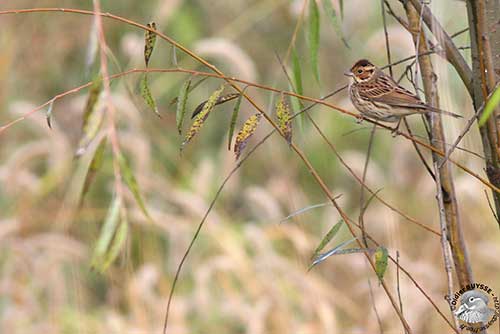
Fr: Bruant nain
Ang: Little Bunting
All: Zwergammer
Esp: Escribano Pigmeo
Ita: Zigolo minore
Nd: Dwerggors
Sd: dvärgsparv
Photographers:
Aurélien Audevard
OUESSANT DIGISCOPING
Didier Buysse
Vision d’Oiseaux
Otto Plantema
Trips around the world
Text by Nicole Bouglouan
Sources:
HANDBOOK OF THE BIRDS OF THE WORLD Vol 16 by Josep del Hoyo- Andrew Elliot-David Christie – Lynx Edicions – ISBN: 9788496553781
THE HANDBOOK OF BIRD IDENTIFICATION FOR EUROPE AND THE WESTERN PALEARCTIC by Mark Beaman, Steve Madge - C. Helm - ISBN: 0713639601
A Field Guide to the Birds of South-East Asia by Craig Robson. New Holland Publishers. ISBN: 9781780090498
BIRDS OF THE MIDDLE EAST by R.F. Porter, S. Christensen, P Schiermacker-Ansen C.Helm - ISBN: 0713670169
ENCYCLOPEDIE DES OISEAUX DE FRANCE ET D’EUROPE – de Peter Hayman et Rob Hume - Flammarion – ISBN : 2082009920
What Bird-The ultimate Bird Guide (Mitchell Waite)
Wikipedia, the free encyclopaedia
THE AVIANWEB - Beauty of Birds (Sibylle Faye)
Birds in Bulgaria – Little Bunting
Little Bunting
Emberiza pusilla
Passeriformes Order – Emberizidae Family
INTRODUCTION:
The Little Bunting is a small passerine in the family Emberizidae. It was first described in 1776 by Peter Simon Pallas, a German zoologist and botanist.
This migratory species breeds across the taiga of NE Europe and N Asia. It winters S in N India, S China and northern SE Asia.
The Little Bunting is widespread throughout its breeding range in summer, and its population is currently stable and not globally threatened.

DESCRIPTION OF THE BIRD:
Biometrics:
Length: 12-14 cm
Wingspan: 20-22 cm
Weight: 12-19 g
The Little Bunting in breeding plumage has deep chestnut head, chin and upper throat, with a conspicuous buffy-white eyering. We can see a broad, dark, lateral crown stripe, and a narrow dark line extending from the rear eye and down around the chestnut cheeks. There is a pale buff patch on the rear ear-coverts. The malar stripe is blackish. The pale buff submoustachial stripe and rear eyebrow contrast with the deep chestnut head. There are some colour variations depending on each individual.
The upperparts are greyish-brown with heavy dark streaking, but the rump shows more indistinct pattern. On the greyish-brown upperwing, the pale tips of median and greater coverts form two pale wingbars. The flight feathers are dark brown with pale reddish edges. The tail is brown with pale edges to outermost rectrices.
The underparts are whitish-buff with conspicuous dark streaks on breast and flanks.
The bill is dark grey with straight culmen and sharply pointed tip. The eyes are dark red-brown. Legs and feet are pinkish.
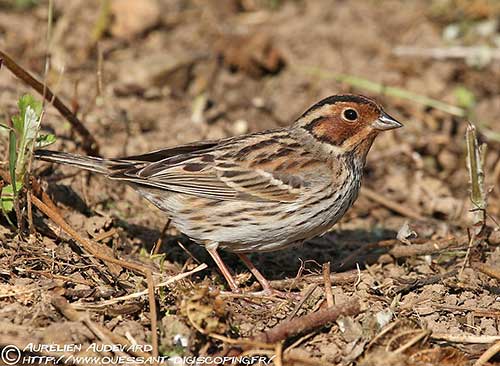
The non-breeding adult has similar plumage but the head pattern differs slightly and shows paler feathers fringes. Median crown-stripe, supercilium, submoustachial stripe and spot on the rear ear-coverts are buffish. Lores and forehead are rufescent and the eyering is whitish.
On the upperparts, the feathers have broader pale fringes, whereas the underparts are darker buff, the belly is whitish and the streaking is more indistinct.
Male and female are similar.
The juvenile resembles adult but it is duller overall, including on the head. The mantle is mostly sandy-buff with dense black streaking. The breast is yellowish-buff and heavily streaked too. The eyes are dark grey-brown.
RANGE:
The Little Bunting breeds in northern Palearctic from NE Norway, Sweden, Finland and N Russia, E across Siberia and Russian Far East.
It winters in N and NE Indian Subcontinent, E to N and C Myanmar, N Thailand, N Indochina and S China.
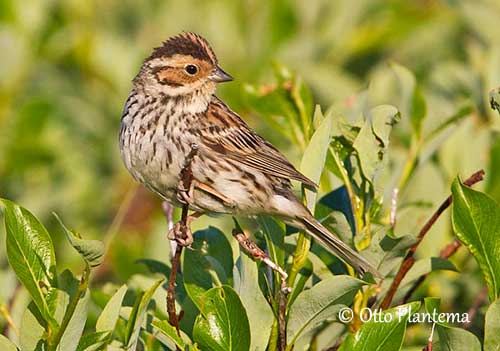
HABITAT:
The Little Bunting breeds across the taiga where it frequents rather open birch or spruce stands with dwarf birch undergrowth, and damp willow thickets, often near water.
It can be seen in more open habitats on passage, such as hedgerows and weedy cultivations.
During winter, it occurs from forest edges to scrubby hillsides, crop fields and paddy fields, bushy areas near marshes, gardens, orchards, edges of roads and paths, up to 2,600 metres of elevation.
CALLS AND SONGS: SOUNDS BY XENO-CANTO
The Little Bunting’s call is a hard, metallic “tik” or harder “tzik” when it is more agitated.
The song is variable, a series of rather metallic notes “zree zree zree tsutsutsutsutsu tzriiitu” and variants such as “pie-pie-sturisturi-tulee-tchee”.
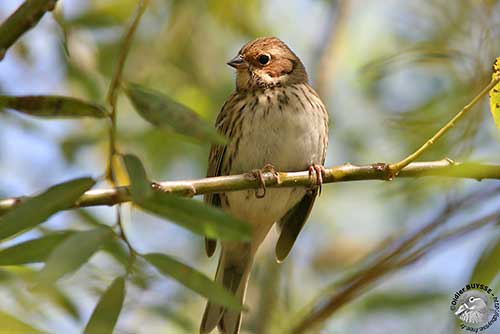
BEHAVIOUR IN THE WILD:
The Little Bunting feeds mainly on seeds and invertebrates, especially during the breeding season. Insects include Ephemeroptera, Plecoptera, Hemiptera, Lepidoptera, Thrichoptera, Diptera, Hymenoptera and Coleoptera. It also takes spiders and earthworms.
The seeds are taken from various plant species and are mainly eaten during winter. They include seeds of grasses, sedges and cereals. Invertebrates are still taken during winter.
The Little Bunting forages primarily on the ground, but it also gleans food items from foliage and low vegetation.
It forages alone, in pairs or in small groups of about 10-12 individuals during winter, sometimes more. It often shares the nightime roosts with the Common Reed Bunting in autumn and winter.
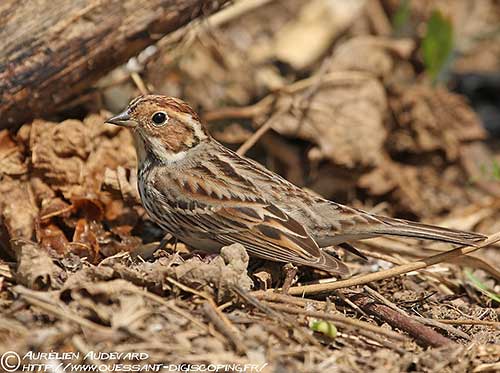
The Little Bunting is monogamous. The male is territorial during the breeding season, and it usually guards its mate during the egg-laying period. The female builds the nest and incubates alone, because she develops an incubation patch whereas this feature is lacking in male. However, the male may feed her at nest, and both parents feed the chicks.
The courtship displays are poorly known, but the male sings to attract a female. The displays occur on the ground or on low branch, where the male displays in front of the female with drooped wings and raised tail, in order to enhance the rich plumage pattern.
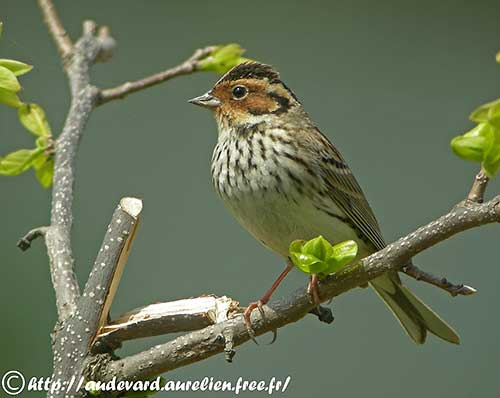
The Little Bunting is migratory and move S in late July and through August, with passage in Mongolia and N China in September/early October.
The return N migration starts in March, with the last departures in early May.
The Little Bunting has swift, bouncy flight with rapid wingbeats interspersed with short glides with the wings pulled to the body.
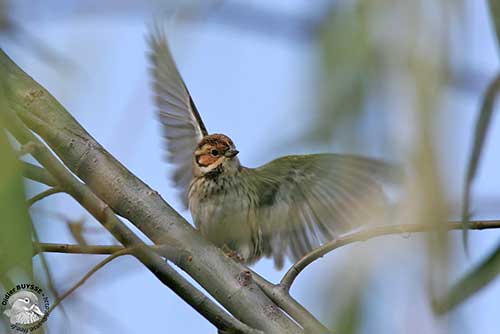
REPRODUCTION OF THIS SPECIES:
The breeding season takes place between early June and July, sometimes August. This species produces a single brood per season.
The female builds the nest on the ground, usually hidden in a clump of grass or low down in tree. It is made with dried leaves, grass, twigs, moss and hair, with a fine lining of softer grasses and moss.
She lays 4-6 green, grey or pink eggs with dark markings. She incubates during 11-12 days. The chicks are fed by both parents and leave the nest at 6-8 days, but they do not fly. They are fully fledged 3-5 days later. They still depend on parents for food.
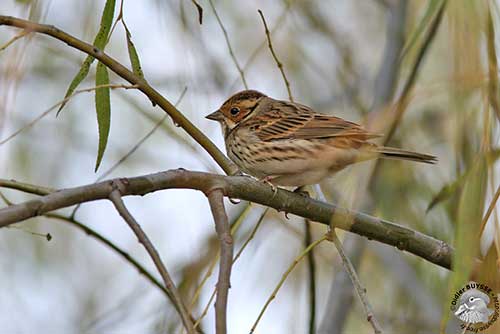
PROTECTION / THREATS / STATUS:
The Little Bunting has very wide range in which it is relatively common.
The global population is roughly estimated to number 30,600,000/96,000,000 individuals. In 2004, the European breeding population was estimated to number 5,000,000/8,000,000 breeding pairs. But further validation if needed.
The population is currently stable, and the Little Bunting is evaluated as Least Concern.
